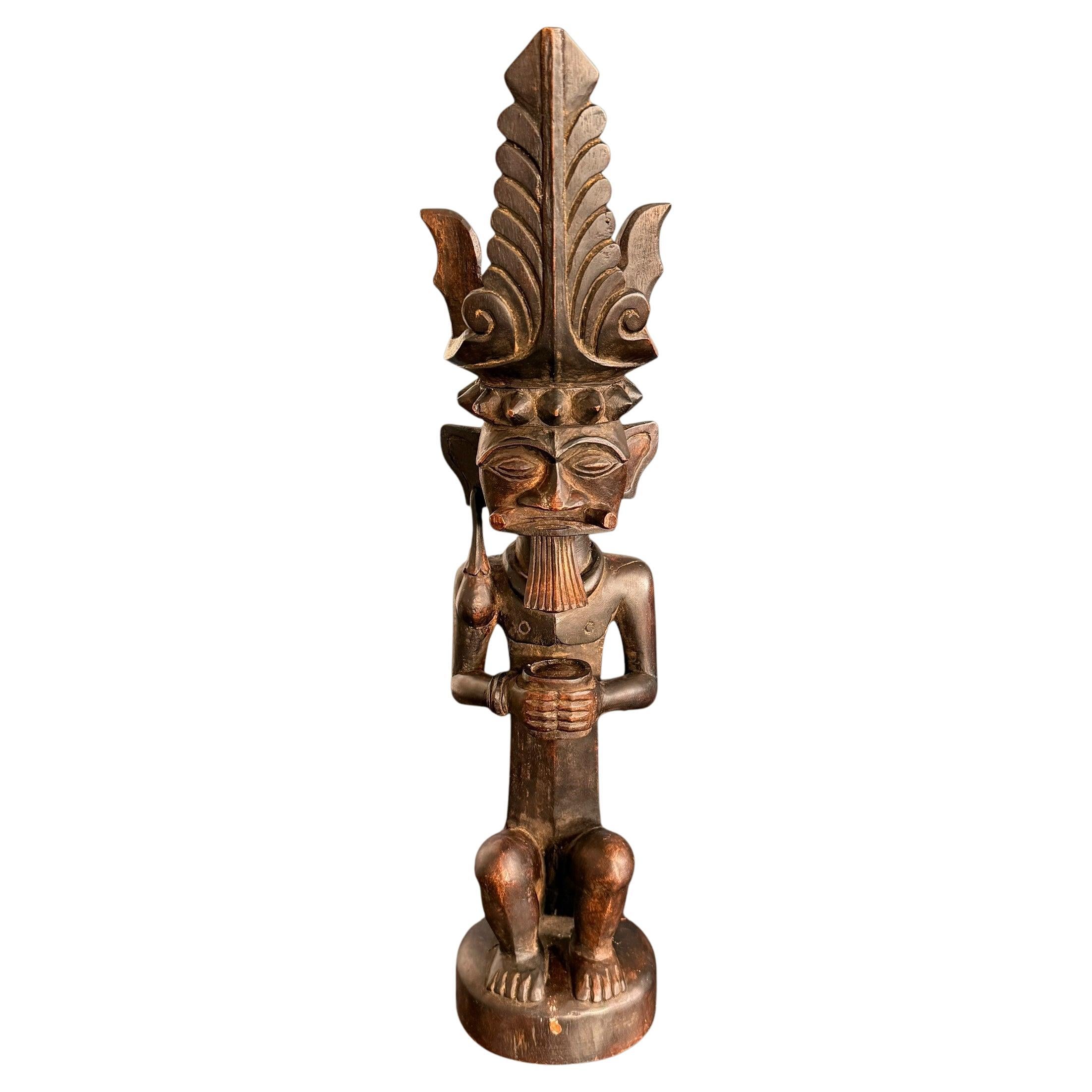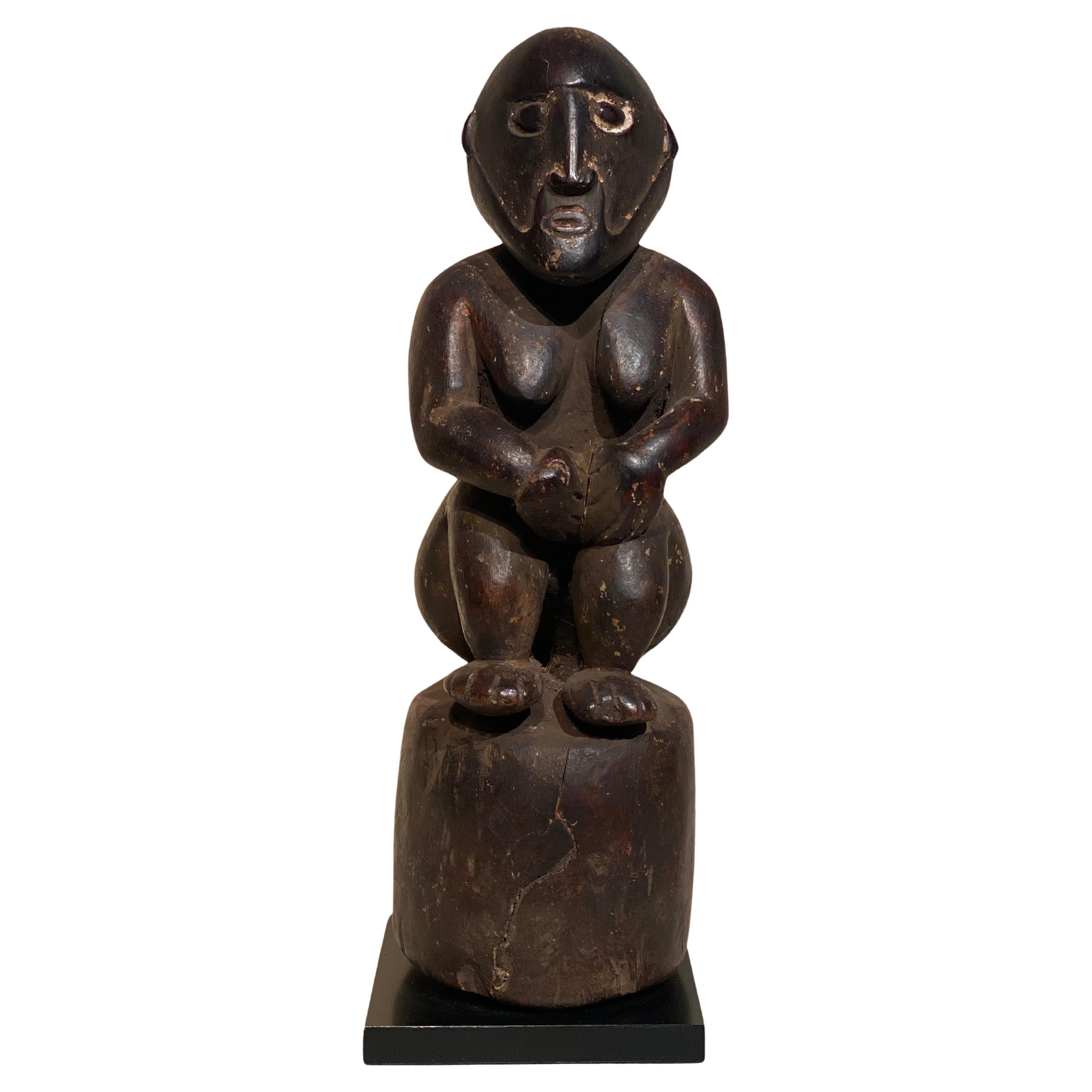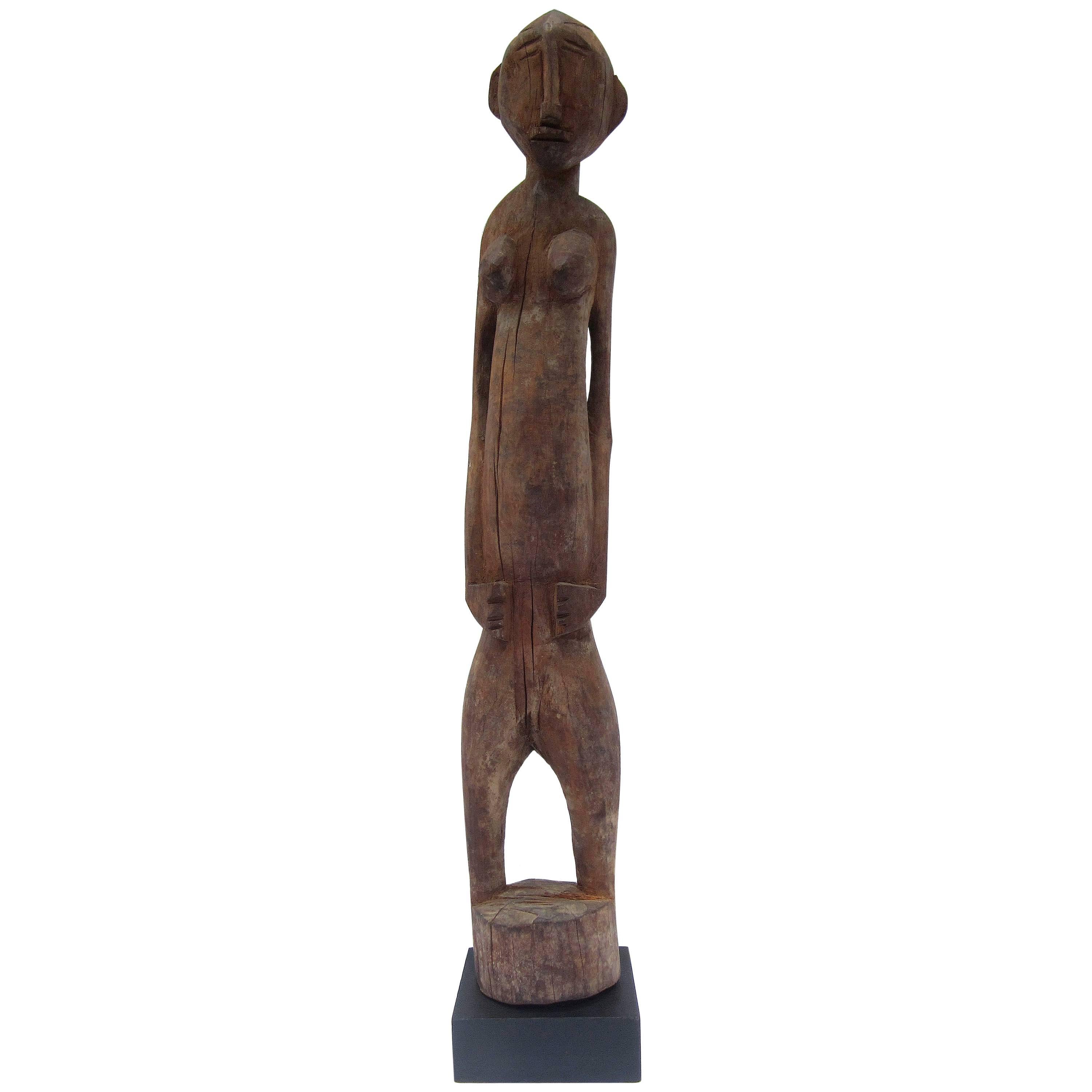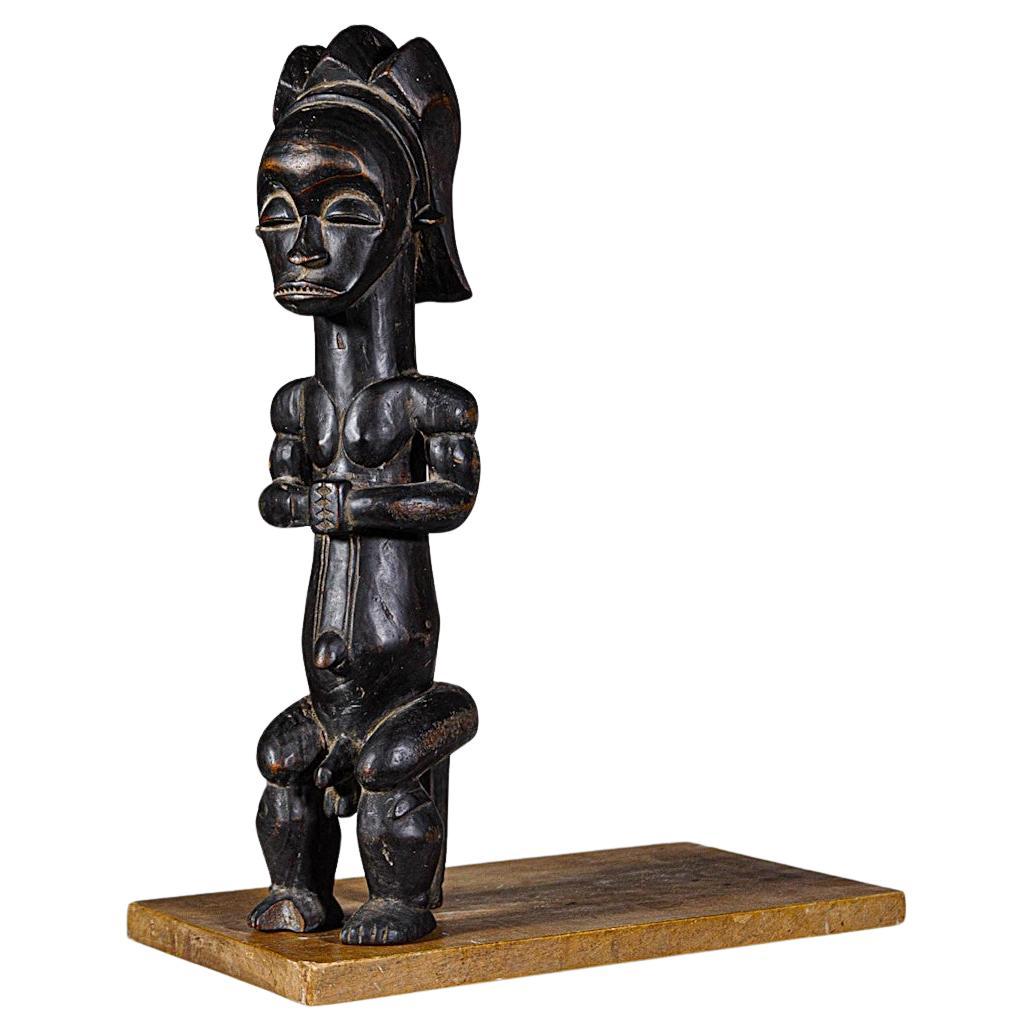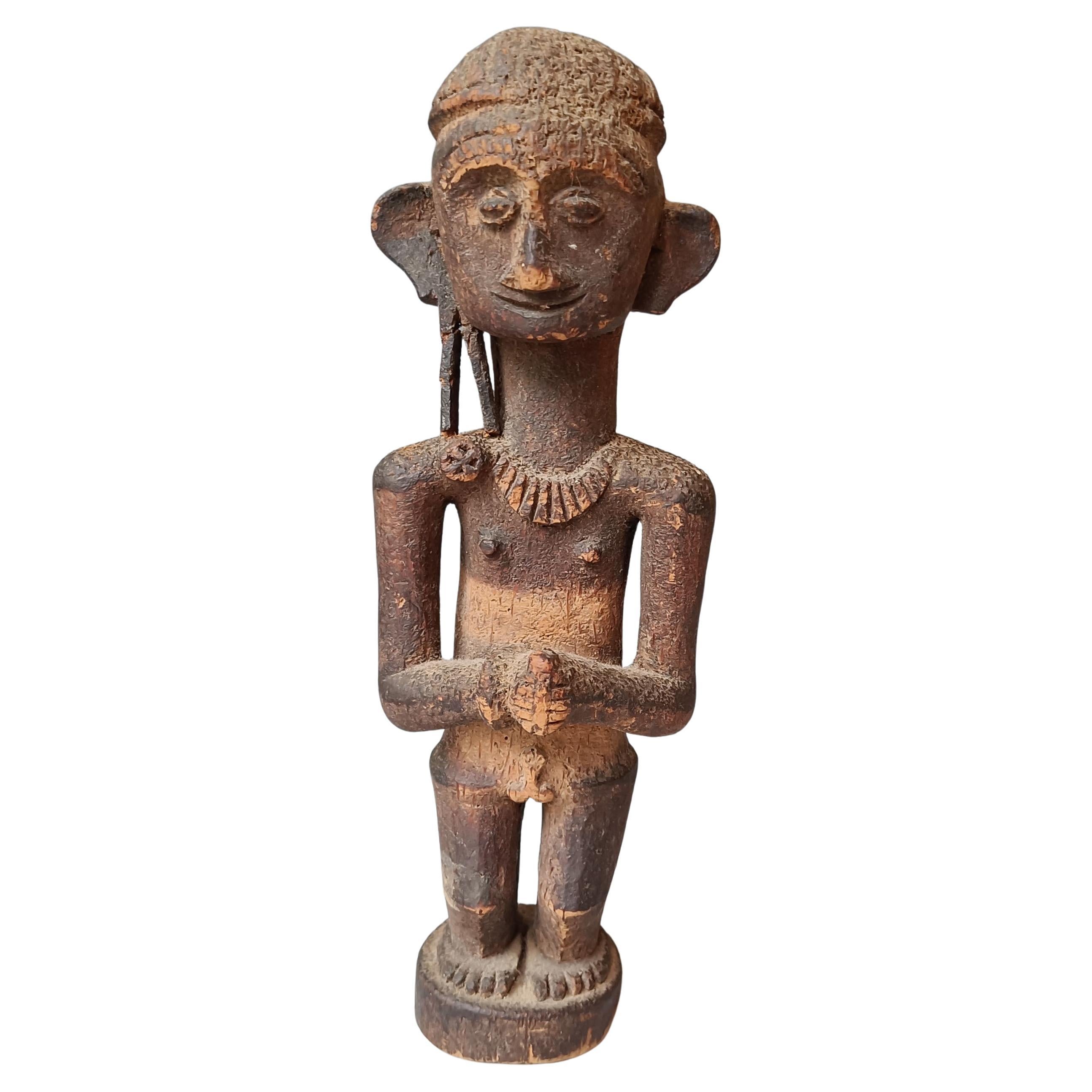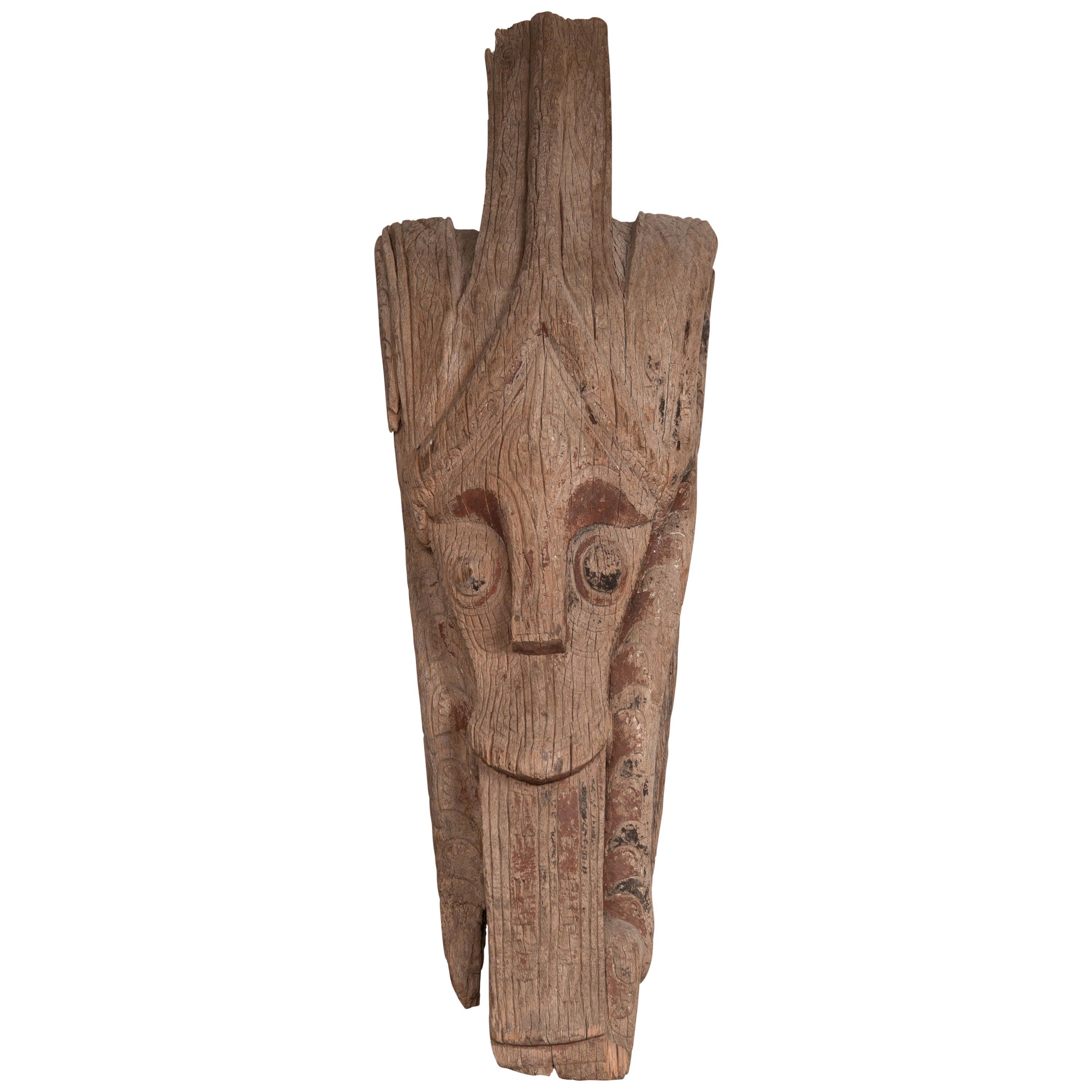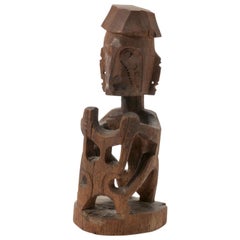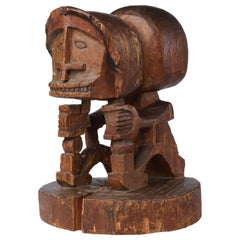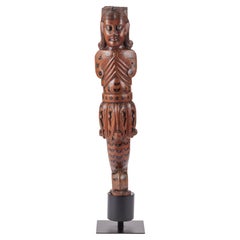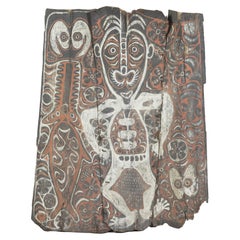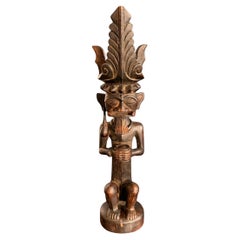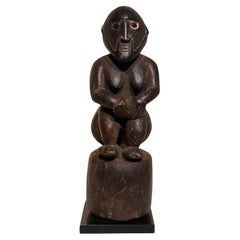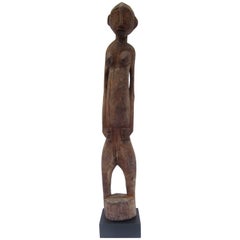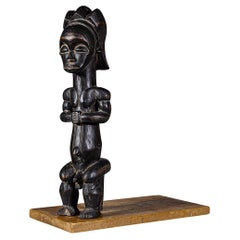Items Similar to A Nias 'Adu Zatua' wooden ancestor sculpture
Want more images or videos?
Request additional images or videos from the seller
1 of 5
A Nias 'Adu Zatua' wooden ancestor sculpture
$20,967.51
£15,606.06
€17,500
CA$28,720.25
A$31,943.19
CHF 16,679.74
MX$388,714.62
NOK 213,025.74
SEK 199,780.56
DKK 133,221.39
Shipping
Retrieving quote...The 1stDibs Promise:
Authenticity Guarantee,
Money-Back Guarantee,
24-Hour Cancellation
About the Item
Indonesia, Nias, 19th century
H. 37.5 x W. 10 cm
Sculptures like the one present are not only decorative items but are believed to be vessels that house the spirits of ancestors and are used to communicate with them.
After the death of a person a wooden image or Adu Zatua was made to mediate between the human world and the spiritual realm. These kinds of figures were commissioned by noble Nias families, whereas simple and lesser quality carvings generally were found among lower class families.
In this particularly fine example, the sculptor has paid careful attention to the proportions of the different parts of the body, dividing it into three main sections – the head, the torso, and the legs. The shapes are sometimes flat, round, or have notches, but all are perfectly in balance creating a certain divine tranquillity. This Adua Zatua’s ears are decorated with earrings, and it is wearing a headdress, pointing towards a chiefly provenance.
In 1914 the Dutch gained complete control of the island of Nias and started spreading Protestant Christianity. Many ancestor statues were destroyed during the ‘Great Penitence’ religious movement in 1916. As symbols of the old religion of ancestor worship they were seen as blasphemous idols. The Dutch painter Rudolf Bonnet (1895-1976) joined his friend Jaap Kunst in March 1930 for a visit to Nias, where Kunst studied the indigenous music. Impressed by the island which remained unspoiled, Bonnet stayd there for almost a year, living with a Nias servant and making many drawings of the people of South Nias. What shocked him, however, was how the Christian mission, in his opinion, was destroying the culture and many of the traditional practices and the heritage of Nias. For a mesmerizing portrait of a Nias warrior by Bonnet, made during his stay on Nias, see: Uit Verre Streken, November 2022, no. 37 (ill.).
Provenance:
Henk Kouw, Amsterdam (1970s)
Collection Peter van Drumpt, Amsterdam
Collection Tijs Goldschmidt, Amsterdam
Private collection, the Hague (1993)
- Dimensions:Height: 14.77 in (37.5 cm)Width: 3.94 in (10 cm)Depth: 3.15 in (8 cm)
- Materials and Techniques:
- Place of Origin:
- Period:
- Date of Manufacture:19th century
- Condition:Wear consistent with age and use.
- Seller Location:Amsterdam, NL
- Reference Number:1stDibs: LU5458237873082
About the Seller
5.0
Recognized Seller
These prestigious sellers are industry leaders and represent the highest echelon for item quality and design.
Established in 1985
1stDibs seller since 2020
23 sales on 1stDibs
Typical response time: 2 hours
- ShippingRetrieving quote...Shipping from: Amsterdam, Netherlands
- Return Policy
Authenticity Guarantee
In the unlikely event there’s an issue with an item’s authenticity, contact us within 1 year for a full refund. DetailsMoney-Back Guarantee
If your item is not as described, is damaged in transit, or does not arrive, contact us within 7 days for a full refund. Details24-Hour Cancellation
You have a 24-hour grace period in which to reconsider your purchase, with no questions asked.Vetted Professional Sellers
Our world-class sellers must adhere to strict standards for service and quality, maintaining the integrity of our listings.Price-Match Guarantee
If you find that a seller listed the same item for a lower price elsewhere, we’ll match it.Trusted Global Delivery
Our best-in-class carrier network provides specialized shipping options worldwide, including custom delivery.More From This Seller
View AllEarly Papua Korwar Statue, Collection of Missionary Starrenburg, Collected 1909
Located in Amsterdam, NL
A Papua wood figure of a Korwar
North West Irian Jaya, Vogelkop area, coastal Geelvink Bay, present-day Cenderawasih Bay, early 20th century
The seated Korwar is holding an ope...
Category
Early 20th Century Indonesian Tribal Tribal Art
Materials
Wood
Early Papua Korwar Ancestor Figure, Early 19th Century, Deep Black-Brown Patina
Located in Amsterdam, NL
An extremely rare Papua wood sculpture of a Korwar
Papua New Guinea, Cendrawasih Bay, Wandammen, early 19th century
Measures: Height 24 x Diameter 18 cm
Finely carved in th...
Category
Antique Early 19th Century Indonesian Tribal Tribal Art
Materials
Wood
$113,823
Free Shipping
Splendid Indo-Portuguese Colonial Sculpture of Nagini from Goa, 17th Century
Located in Amsterdam, NL
A fine Indo-Portuguese inlaid teak wood figure of Nagini
India, Goa, 17th century
Measure: H. 55 cm
(with stand, and with ring for wall hanging)
The sculpture can be perceived as such but probably is one of four legs of an Indo-Portuguese contador...
Category
Antique 17th Century Indian Jewelry Boxes
Materials
Teak, Ebony
A Sepik 'panggal' sago spathe or tree bark painting of an ancestral figure
Located in Amsterdam, NL
East-Sepik Province, Keram River, early 20th century
The painting in non-binded pigment on sago spathe, bark of a sago palm, depicts an ancestral figure surrounded by a saw fish...
Category
Early 20th Century Papua New Guinean Tribal Art
Materials
Wood
A rare Papua 'Gope' Spirit board from the Schulze Westrum collection
Located in Amsterdam, NL
A rare Papua 'Gope' Spirit board from the Schulze Westrum collection
New Guinea, Papua Gulf, probably Minagoiravi, Wapo River, late 19th–early 20th century
H. 130 x W. 24.5 cm
Pro...
Category
Antique Late 19th Century Papua New Guinean Tribal Art
Materials
Wood
An ancient Papua wooden substitute headhunters's head
Located in Amsterdam, NL
Papua New Guinea, 18th-19th century
L. 22.5 x W. 18 cm (approx.)
Provenance:
Collected by Schulze-Westrum
Collection Rinck Hollnberger, Munich (purchased in the 1980s or 1990s)
For a comparable skull see the collection of the Metropolitan Museum of Art in New York.
The heads of humans and of animals such as crocodiles and pigs formerly played integral roles in the ceremonial life of Papuan Gulf peoples, who considered the heads to be vessels of life-giving supernatural power. Within men’s ceremonial houses, human skulls were displayed, together with sacred images such as spirit boards or gope, by the members of each clan in a specially constructed clan shrine. However, not all heads required the death of an enemy. In some areas, heads made from wood or other materials appear to have had powers equal to actual ones. In contrast to skulls, the facial features of wood heads were sometimes depicted as they appeared in life.
This example comes from the Wapo Creek area, where wood heads appear to have been used interchangeably with actual skulls. When headhunting was abolished by Australian colonial...
Category
Antique 19th Century Papua New Guinean Tribal Art
Materials
Wood
You May Also Like
A wooden statue Siraha Salawa nobel Nias Ancestor Figure Indonesia
Located in Chonburi, TH
This wooden statue from Siraha Salawa, a noble Nias ancestor figure from Indonesia, is a striking example of Nias artistry and cultural heritage. Carved from a single piece of wood, ...
Category
Antique 19th Century Indonesian Tribal Art
Materials
Wood
Tribal Wooden Statue From Papua New Guinea
Located in Schellebelle, BE
An beautiful Wooden Statue from Papua New Guinea from the Sepik Region,
a seating figure with the typical Sepik features,
good patina and shine of the wood, powerful object
Category
Vintage 1970s Asian Tribal Art
Materials
Wood
Tribal Wood Carved Statue
Located in East Hampton, NY
Tribal wood carved statue. Unknown origin.
Category
20th Century Figurative Sculptures
Materials
Wood
A Tribal Art Byeri Fang Sculpture Gabon 1980's
Located in HYÈRES, FR
A Tribal Art Byeri Fang Sculpture Gabon 1980's
Very nice decorative sculpture.
Beautiful black and shade of red.
Late work from Southern Gabon.
Repo...
Category
Vintage 1980s Gabonese Tribal Art
Materials
Wood
19th Century Indonesian Nias Ancestor Figure (Adu Zatua) – Tribal Art
Located in London, GB
19th Century Indonesian Nias Ancestor Figure (Adu Zatua) – Tribal Art from the Nias Islands
A captivating Adu Zatua ancestor figure from the Nias Islands, Indonesia. Expertly hand-...
Category
Early 20th Century Indonesian Textiles
Materials
Cotton
Hand-Carved Batak Singa Singa Tribal Sculpture, Sumatra, Antique Decor Accent
Located in Yonkers, NY
A antique hand carved tribal sculpture from the Batak People, northern Sumatra, called a Singa Singa. This antique hand-carved tribal sculpture from the Batak People of Northern Suma...
Category
Antique 19th Century Indonesian Tribal Sculptures and Carvings
Materials
Wood
More Ways To Browse
Antique Wooden House
Religious Art Wooden
Antique Indonesian Wood Carvings
Indonesian Statue
Antique Idols
Antique Wooden Religious Statues
Indonesian Warrior
Indonesian Headdress
Tribal Wooden Vessel
Indonesian Wooden Statue
Rudolf Bonnet
New Guinea Figure
Adze Used
Mali Bambara
West African Mask
African Iron Currency
Beaded African Figure
Dogon Mali
